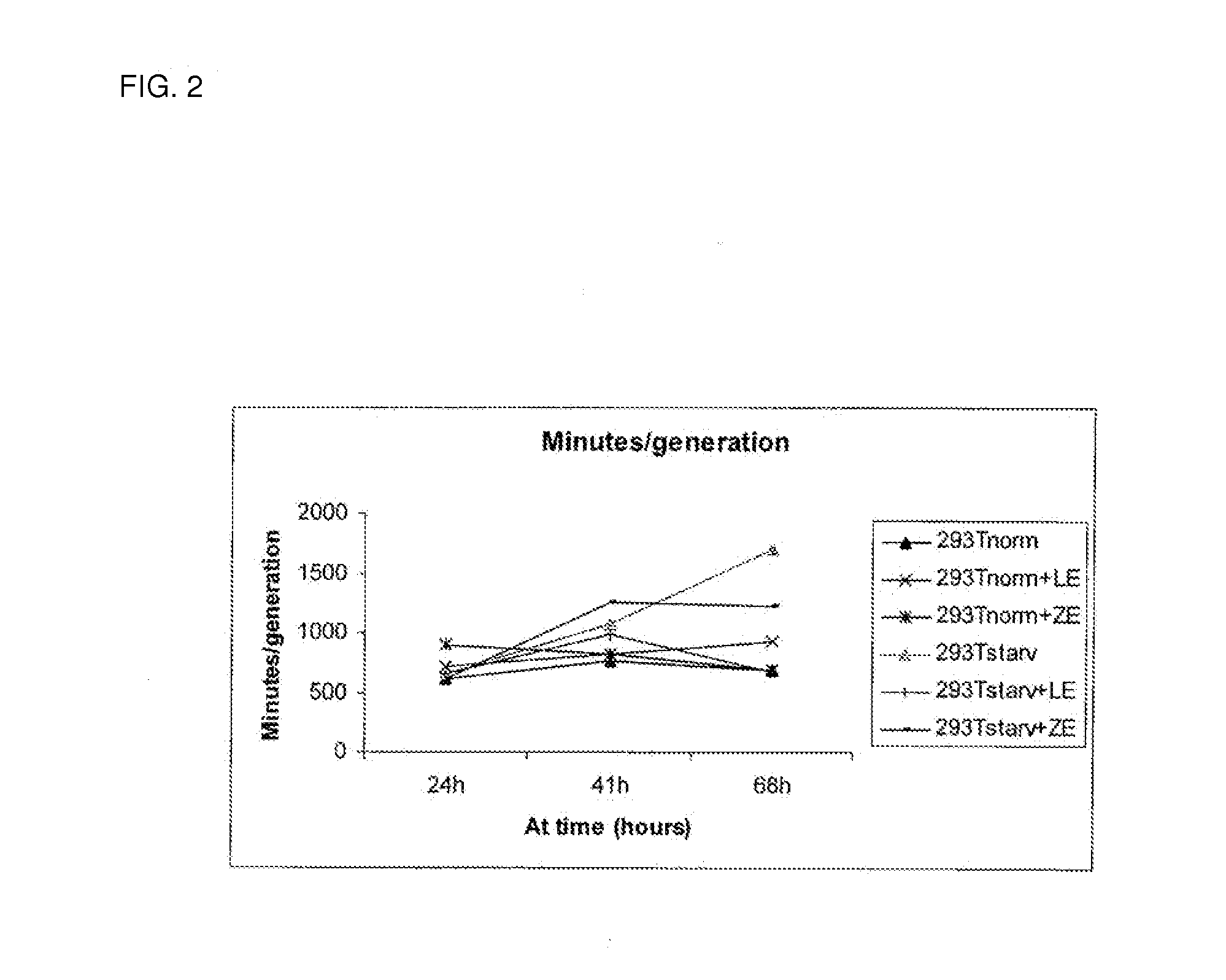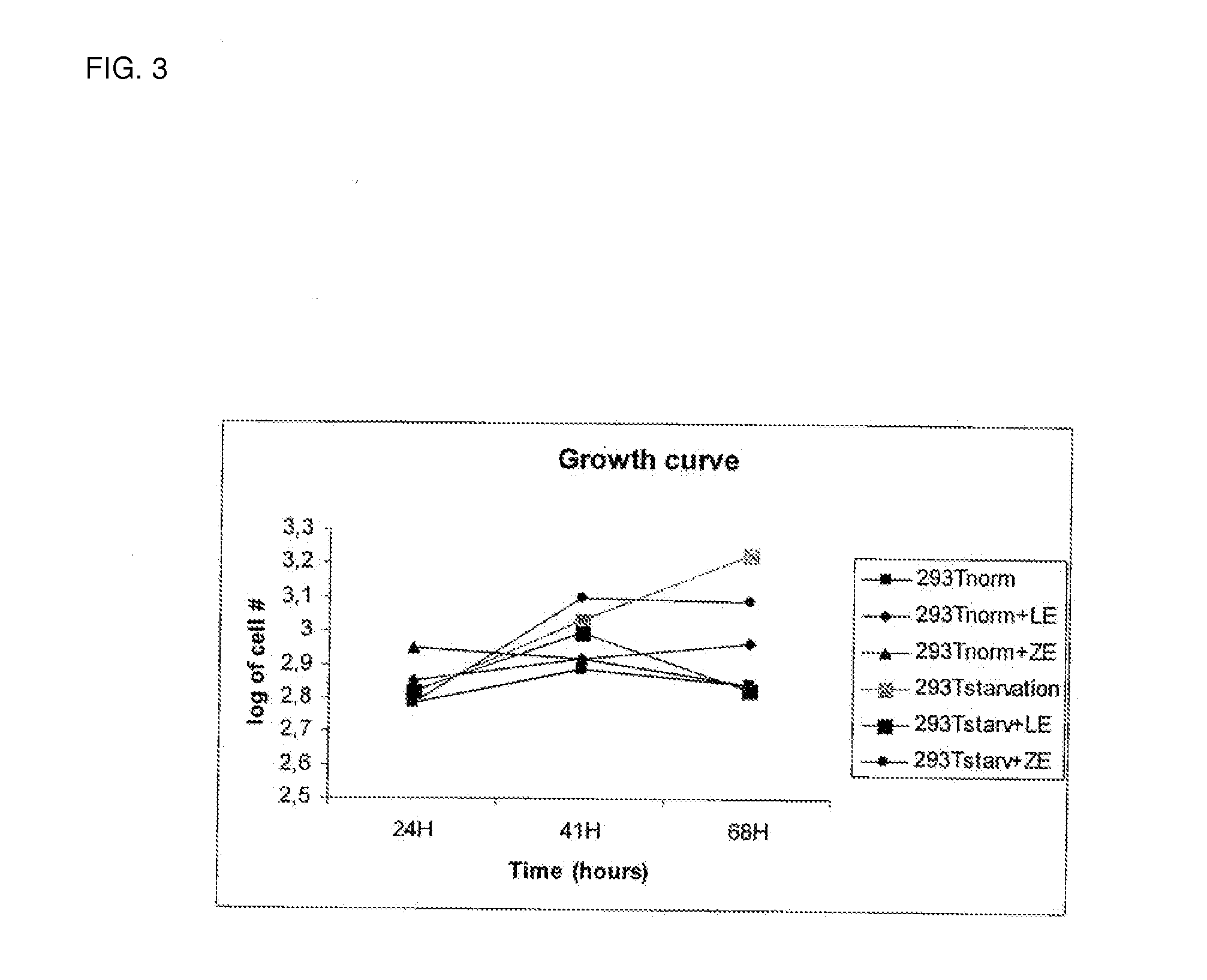Cellular extracts
a technology of extracts and cellular components, applied in the field of cellular extracts, can solve the problems of incomplete regeneration of tissue or organs, skin damage and potentially cancer, and skin cells may become damaged by physical means, and achieve the effect of faster reepithelialization and faster drying
- Summary
- Abstract
- Description
- Claims
- Application Information
AI Technical Summary
Benefits of technology
Problems solved by technology
Method used
Image
Examples
example 1
Cells and Cell Extracts
[0309]NCCIT, Jurkat (clone E6-1) and 293T cells (American Type Culture Collection, Bethesda, Md.) are cultured in RPMI 1640 (Sigma, St. Louis, Mo.) with 10% fetal calf serum (FCS), 2 mM L-glutamine, 1 mM sodium pyruvate and non-essential amino acids (complete RPMI). NIH3T3 Swiss-Albino fibroblasts (American Type Culture Collection) are cultured in Dulbecco's modified Eagle's medium (DMEM; Sigma) with 10% FCS, L-glutamine and 0.1 mM β-mercaptoethanol. Mouse ESCs are isolated from inner cell masses of strain sv129 blastocysts and plated on mouse fibroblast γ-irradiated feeder layers in ESC medium (DMEM, 15% FCS, 0.1 mM β-mercaptoethanol, non-essential amino acids, 1% penicillin / streptomycin) supplemented with 1,000 units / ml (10 ng / ml) of recombinant leukemia inhibitory factor (LIF; Sigma) on gelatin-coated plates. Prior to harvesting for preparing extracts, ESCs are passaged and cultured under feeder-free conditions in RPMI containing 10 ng / ml LIF.
[0310]To prepa...
example 2
Bulge Hair-Follicle Stem Cells
[0311]To isolate the vibrissa follicles, the upper lip containing the vibrissa pad of a subject is cut and its inner surface was exposed. In human individuals, hairs from the scalp or other haired body parts may be used instead of vibrissa. The vibrissa or hair follicles are dissected under a binocular microscope. The vibrissa are plucked from the pad by pulling them gently by the neck with fine forceps. The isolated vibrissae were washed in DMEM-F12 (GIBCO / BRL), containing B-27 (GIBCO / BRL) and 1% penicillin / streptomycin (GIBCO / BRL). All surgical procedures were done under a sterile environment. The vibrissa follicular bulge area contained nestin expressing cells. The cells were isolated by exposure to fluorescent anti-nestin antibodies under fluorescence microscopy. The isolated cells were suspended in 1 ml of DMEM-F12 containing B-27 with 1% methylcellulose (Sigma-Aldrich), and 20 ng·ml−1 basic FGF (bFGF) (Chemicon). Cells were cultured in 24-well tis...
example 3
Ex vivo Therapy
[0312]Cells to be reprogrammed ex vivo are washed in cold PBS and in cold Ca2+- and Mg2+-free Hank's balanced salt solution (HBSS; Invitrogen, Gaithersburg, Md.). Cells are resuspended in aliquots of 100,000 cells / 100 μl HBSS, or multiples thereof, placed in 1.5 ml tubes and centrifuged at 120 g for 5 min at 4° C. in a swing-out rotor. Sedimented cells are suspended in 97.7 ml cold HBSS, tubes placed in a H2O bath at 37° C. for 2 min and 2.3 ml SLO (Sigma; 100 mg / ml stock diluted 1:10 in cold HBSS) is added to a final SLO concentration of 230 ng / ml. Samples are incubated horizontally in a H2O bath for 50 min at 37° C. with occasional agitation and set on ice. Samples are diluted with 200 ml cold HBSS and cells are sedimented at 120 g for 5 min at 4° C. Permeabilization is assessed by monitoring uptake of a 70,000 Mr Texas red-conjugated dextran (Molecular Probes, Eugene, Oreg.; 50 μg / ml) in a separate sample 24 h after resealing and replating the cells. Permeabilizati...
PUM
 Login to View More
Login to View More Abstract
Description
Claims
Application Information
 Login to View More
Login to View More - R&D
- Intellectual Property
- Life Sciences
- Materials
- Tech Scout
- Unparalleled Data Quality
- Higher Quality Content
- 60% Fewer Hallucinations
Browse by: Latest US Patents, China's latest patents, Technical Efficacy Thesaurus, Application Domain, Technology Topic, Popular Technical Reports.
© 2025 PatSnap. All rights reserved.Legal|Privacy policy|Modern Slavery Act Transparency Statement|Sitemap|About US| Contact US: help@patsnap.com



